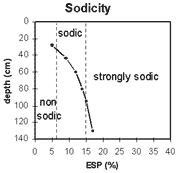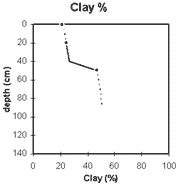NE39
| Property: Rutherglen Research Institute | Paddock #: 28 |
| Aust. Soil Class.: Bleached-Sodic, Eutrophic, Yellow DERMOSOL | Northcote Factual Key: Gn 4.6 |
| Great Soil Group: no suitable group | Map Unit: Rutherglen loam (brown phase) |
| General Landscape Description: Higher part of plain. | |
Soil Profile Morphology:
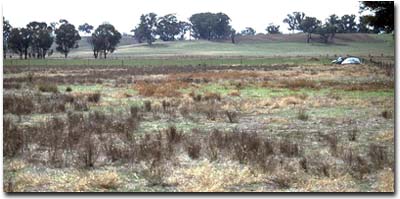
NE39 Landscape
Surface Soil
| A11 | 0-10 cm | Brown (10YR4/3); fine sandy clay loam; weak coarse blocky structure; weak consistence moist; pH 4.7; clear change to: | 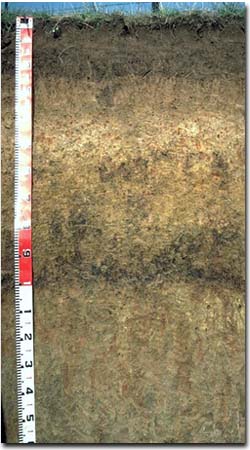 NE39 Profile |
| A12 | 10-20 cm | Brown (7.5YR4/4); fine sandy clay loam; weak coarse blocky structure; contains a few (2-5%) manganese nodules (2-5 mm size); pH 5.1; abrupt change to: | |
| A2 | 20-35 cm | Very pale brown (10YR7/4) [with patches of yellow (10YR7/6)] conspicuously bleached (7.5YR8/2d); fine sandy clay loam; weak coarse blocky structure; very firm consistence dry; contains a few (5-10%) hard clay and ferromanganiferous nodules; pH 6.7; clear change to: | |
| Subsoil | |||
| B1 | 35-50 cm | Very pale brown (10YR7/4); fine sandy clay loam (becoming light clay with depth); weak coarse polyhedral structure contains a few (2 - 5 %) hard clay and ferruginous nodules; pH 8.0; clear change to: | |
| B21 | 50-70 cm | Brownish yellow (10YR6/6); medium clay; moderate coarse polyhedral structure; (manganese stains present); pH 8.0; gradual change to: | |
| B23 | 70-90 cm | Very pale brown (10YR7/3) with brownish yellow (10YR6/6) mottles; medium clay; moderate coarse polyhedral, breaking to moderate medium polyhedral structure; contains manganese stains; pH 8.0; clear change to: | |
| B24 | 90-100 cm | Reddish yellow (7.5YR6/6); medium clay; moderate coarse polyhedral, breaking to moderate medium polyhedral structure; structure; contains very many (50%) manganese stains; pH 8.3; clear change to: | |
| B3 | 100-160+ cm | Light yellowish brown (10YR6/4) with yellowish red (5YR5/8) mottles; light medium clay; moderate coarse polyhedral, breaking to moderate medium polyhedral structure (shiny faced peds); firm consistence dry; pH 8.7. | |
Key Profile Features:
- Lack of strong texture contrast between surface (A) horizons and subsoil (B21) horizon.
- Presence of many manganese stains in deeper subsoil (ie. between 50 - 100 cm depth).
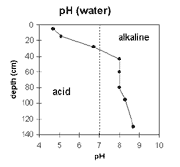 | The surface (A1) horizons are very strongly acid to strongly acid. The subsurface (A2) horizon is slightly acid. The upper subsoil is moderately alkaline and the deeper subsoil becomes strongly alkaline. | 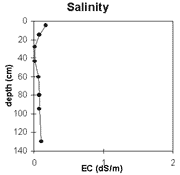 | The level of soluble salts is very low throughout the soil profile. |
| The surface horizons are non-sodic. The upper subsoil is sodic and the deep subsoil is strongly sodic. Strong dispersion occurs in the B21 and deeper horizons |
| The clay percentage increases gradually with depth in the upper subsoil. |
Management Considerations:
Whole Profile
- Plant available water capacity (PAWC) is considered to be low (estimated at 85 mm) for the top metre of the soil profile. This is based on available laboratory data.
- The surface soil is very strongly acid. Aluminium becomes more soluble in soils at low pH levels. The level of exchangeable aluminium measured in the surface horizon (78 ug/g) may restrict the growth of highly aluminium sensitive species. The level of exchangeable aluminium reduces to a low level in the subsurface (A12) horizon.
- Molybdenum deficiency may also occur in the strongly acid surface soil.
- The subsurface (A12 and A2) horizons disperse slightly-moderately after remoulding. Deep tillage should therefore be avoided if these horizons are in a moist to wet condition.
- The surface soil has a high fine sand and silt content. Organic matter is therefore important for maintaining aggregation and preventing slaking.
- The subsoil horizons are sodic and disperse. This will result in restricted root and water movement through the subsoil.
- The presence of a large amount of manganese staining in the mid subsoil (ie. between 50 - 100 cm depth) may have a toxic effect on deeper rooted manganese sensitive species.
- Disc ploughed (1971)

